Cedrus: True Cedars
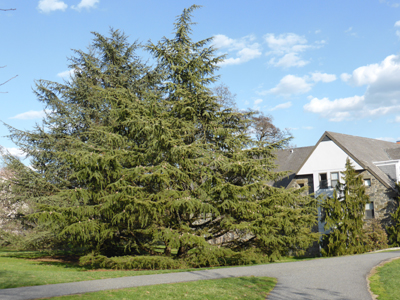 My first encounter with the genus Cedrus occurred while flipping through the pages of On Gardening by Penelope Hobhouse. The tree commanded presence in the photo. The singular plant, a conifer planted at Tintinhull House, a garden in England, evoked a feeling akin to Africa or Australia. I had never seen such a tree; the evergreen looked nothing like the “cedars” (Juniperus virginiana) native to my childhood home in Western Virginia. My first physical encounter occurred when visiting the Scott Arboretum for the first time. While smaller in stature than the plant at Tintinhull House, the Entrance Garden Cedrus was no less commanding.
My first encounter with the genus Cedrus occurred while flipping through the pages of On Gardening by Penelope Hobhouse. The tree commanded presence in the photo. The singular plant, a conifer planted at Tintinhull House, a garden in England, evoked a feeling akin to Africa or Australia. I had never seen such a tree; the evergreen looked nothing like the “cedars” (Juniperus virginiana) native to my childhood home in Western Virginia. My first physical encounter occurred when visiting the Scott Arboretum for the first time. While smaller in stature than the plant at Tintinhull House, the Entrance Garden Cedrus was no less commanding.
The Hillier Manual of Trees and Shrubs summarizes the genus Cedrus as follows: “The Cedars are a small genus of 4 species of evergreen trees renowned for their grandeur and longevity. Young trees are conical in outline, developing often a massive trunk and large, horizontal branches as they age. They are among the most popular of all trees for specimen plantings but owing to their eventual size are only suitable for parks, open areas and large gardens.”
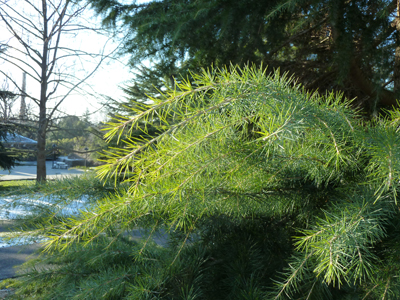
The new lemon-lime growth of Cedrus deodora 'Roman Gold' is beaming in the setting sun. photo credit: J. Coceano
Cedrus species range from the Mediterranean region to the Himalayas. Trees are commonly seen cultivated in North America and across Europe. Cedars are particularly popular in England. The opening credits of Downton Abbey, a well-liked series on PBS, features shots of majestic Lebanon cedars thought to be brought as seed from Lebanon in the 17th century. Other characteristics of the species include needle-like leaves arranged in a spiral pattern on terminal branches and barrel-shaped seed cones that sit atop the branches. Oils within the bark repel insects. The aromatic deodorizing properties coupled with the attractive grain patterns of the wood resulted in cedars being the wood of choice to make modern-day cedar chests and closets for storing fabrics such as wool.
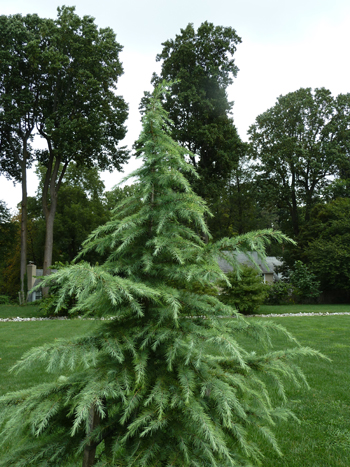
Cedrus deodora 'Silver Mist' is a slow growing varieity with silver-hued needles. photo credit: J. Coceano
The Scott Arboretum features three of the four Cedrus species. Only Cedrus brevifolia, the Cyprus cedar, is not represented in the collection. Restricted to a small area in the Troodas Mountains on the island of Cyprus, Cedrus brevifolia is similar to C. libani and is frequently listed as a subspecies of C. libani. Needle length is the primary difference between the two species with C. brevifolia featuring shorter needles compared to C. libani. Cited on the Threatened Conifer of the World website, a subset of the Royal Botanic Garden Edinburgh, conservation practices including human and grazing exclusion and ex-situ gene banks are in place to help protect the rare species.
As Cedrus brevifolia is the rarest, Cedrus atlantica, the Atlas cedar, is the most well-known and commonly cultivated. Needles are gray greenish blue. The cultivar ‘Glauca’ and its many clones, often grouped together as Glauca Group, boast steel blue needles. Seedlings show a range of needle coloration. Once established, C. atlantica is more tolerant of heat and dry soil than C. libani or C. deodora. A specimen of Cedrus atlantica Glauca Group can be seen in the Entrance Garden at the Arboretum.
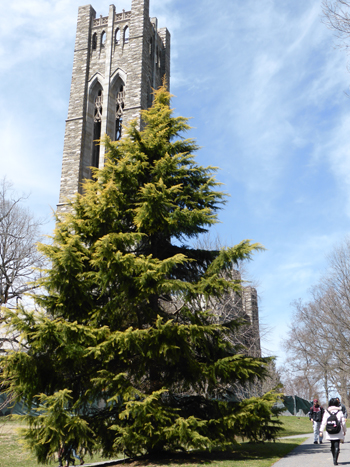
Cedrus deodora 'Roman Gold' underneath the bell tower of Clothier Memorial Hall. photo credit: J. Coceano
Cedrus deodora is a personal favorite in part due to its pendant nature and longer needles which give the tree a softer look. The species bears several cultivars including ‘Karl Fuchs’ a particularly hardy blue-green cultivar, ‘Roman Gold’ with lemon-lime new growth; ‘Shalimar’ introduced by the Arnold Arboretum, sports blue-green needles and is one of the hardiest cultivars; and ‘Silver Mist’ a slow growing variety with silver-hued needles. Blue Sterling Nursery in New Jersey introduced ‘Blue Ball’, a very low growing globe-shaped deodar cedar that has vivid blue-grey color. The size of the original plant after 15 years is only 30″ high and 36″ wide
Cedrus libani, the cedar-of-Lebanon, is particularly slow growing and native to mountainous areas of Lebanon, Syria and Turkey. Like the other species, it transitions from a conical shape to broad-spreading with age. Lower limbs often remain on the tree and frequently spread across the ground. The tree is the national emblem of Lebanon and appears in the center of the Lebanese flag.
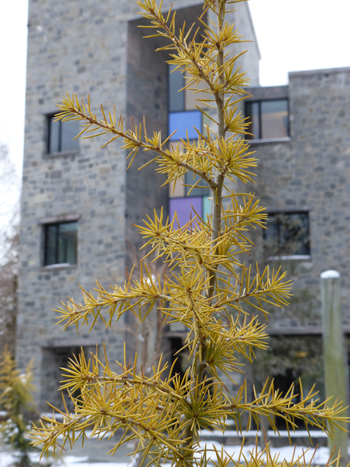
Cedrus deodora 'Aurea' is featured in the winter containers in Cosby Courtyard. photo credit: J. Coceano
Cedrus should be sited in locations that mimic the hills and mountains of their native range. While slow growing in youth, trees develop large spreading canopies and require ample room to spread out. Trees are tolerant of dry conditions once established. Severe winter cold and heavy snow loads are a concern. Few pests and disease trouble the plant, though the genus is a food source for different Lepidoptera species.
While perhaps not a tree for every garden, Cedrus is a majestic genus rooted deep in history, lore, and national pride. Specimens can be found near the Cunningham House, bordering Parrish Lawn, and around Old Tarble and McCabe Library.





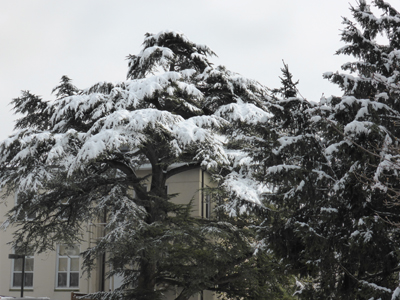
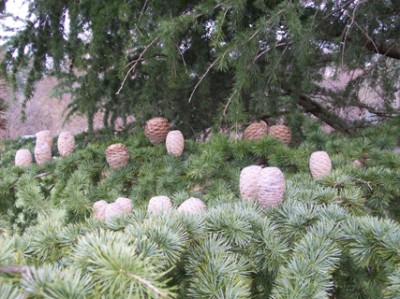
No Comments